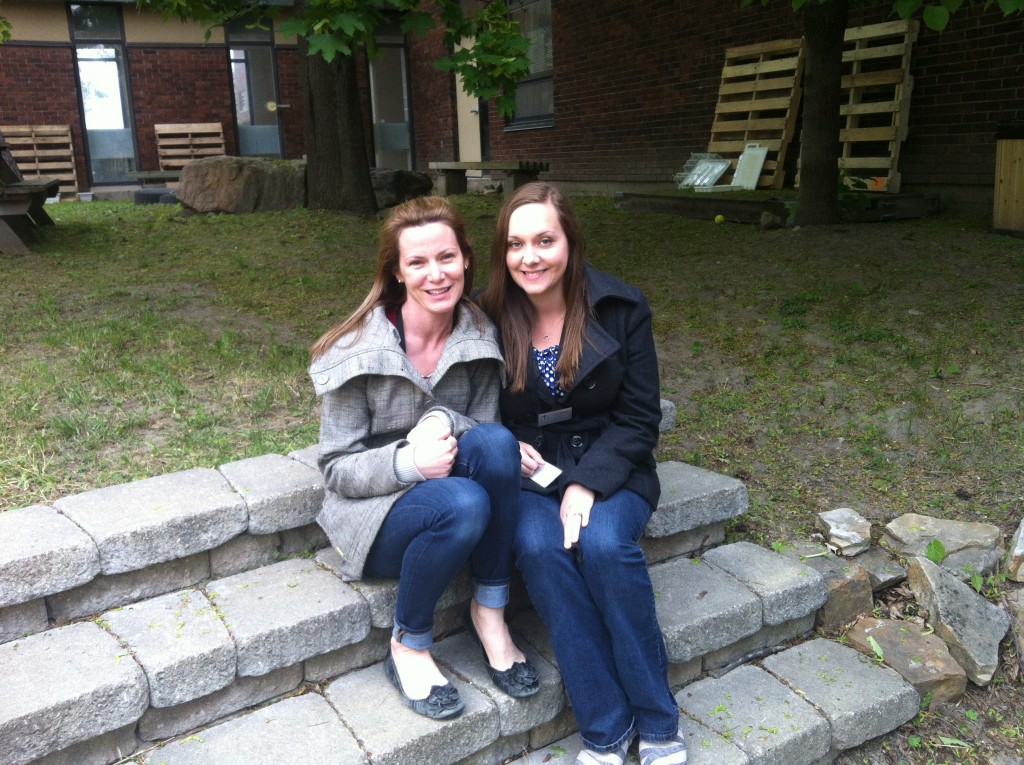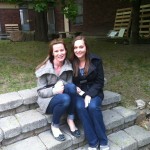We are lucky enough to have an outdoor courtyard/enclosed space in the middle of our school. We wanted to revamp this area into an outdoor classroom space, with an added focus on using technology to connect students with the environment/natural spaces. There is much research that speaks to how outdoor education improves educational outcomes overall, increases student motivation and decreases behaviours. The outdoor classroom is a very hot topic right now, particularly with the all-day kindergarten program, as it actually references the “outdoor classroom” right in its curriculum document, and with more accredited Forest Schools popping up (one right near us), it does not take much Googling to find resources and research in the area of the outdoor classroom. We already had a beautifully defined area that we easily “tweaked” to guide it on the path to becoming a functional and highly engaging outdoor classroom, and were focussing on using technology to capture and support our inquiries. Digital/mobile devices are such a huge part of our lives today; we wanted to embrace that and bridge it with the need to be outdoors more. We believe that bringing mobile learning into outdoor classrooms will equal authentic, engaged learning for students and teachers alike… after all, we too are “life-long learners” and continuously learn alongside our students.
Team Members
Tammy Maxsom-Hunt
OCDSB
Lara Simoes
OCDSB
Team Photo

Professional Learning Goals
- explored and became more familiar with outdoor classroom learning spaces and material ideas, and established our vision for an outdoor learning space
- investigated which technology devices/materials that capture and support/promote learning would be best suited for outdoor classroom learning spaces, and research which would be able to withstand the elements and be durable for hands-on learning and offer open-ended possibilities
- created an outdoor learning space that incorporated the use of technology, and made connections and built partnerships within the community to help build an outdoor classroom
- created a Google shared calendar for people to reserve the “Co-operative Courtyard (outdoor classroom)”
- created a shared folder on Google Drive for teachers to share ideas, experiences and resources
Activities and Resources
As a team, we worked together to research various websites, blogs and Facebook accounts that would help guide us and give direction for what we wanted to accomplish. Let the Children Play website and Forest Schools were at the top of our list for inspiration.
We also visited a few sites around our city that also had model outdoor learning spaces already in place, as well as joined a nature group that focussed on early learning in the outdoors (Ottawa Nature Collaborative).
We visited our own resource room and gathered texts that would support outdoor learning and asked the librarian to kindly add a “tag” (outdoor learning) in the computer system for these items so that others can easily locate them and hopefully use them more.
We spent a lot of time researching mobile devices that would work best outdoors and decided on an iPad mini, wireless mobile microscope (has an app that works with the iPads) and water-resistant Bluetooh speakers.
We also went shopping for outdoor classroom items! Spent a lot of time at places like Value Village gathering things for the mud kitchen, etc.
The physical labour part was when we had to go into the run-down courtyard and clean it up. We pruned trees, raked, whipper-snipped, transplanted items, buried tires partially (to house outdoor building materials) and stained wood pallets… over 20 bags of filled “yard” waste, 10 bundles of tree branches sawed into pieces, and lots and lots oohs and aahs from onlookers. This was really the bonding part as we were seeing our vision start to unfold. Students walking by asked if they could help, as did a few other staff.
Establishing a “Next Steps” list, shared folder for future collaboration, shared calendar for reserving the space, and support (future workshops) for using some of the devices is our final step in this chapter of our journey.
Unexpected Challenges
Finding suitable technology was tricky. We originally had desired to have an outdoor LCD projector and a screen, but learned that attaining one that would project outside in daylight would be very expensive and ultimately not feasible.
As we got looking into more of the outdoor learning component, we ended up shifting our focus more on researching materials and resources for that, and used the angle of mobile devices to capture and extend the learning rather than lead it.
Outdoor classrooms is a huge topic right now so we really needed to prioritize and focus specifically on what was achievable given our parameters (money, time, bodies), and reflected that this was just a starting point and that we would need to establish maintenance plans and next steps for it to continue to move forward in the weeks/months/years to come. We ended up taking more release time than originally planned to help achieve our goals.
Enhancing Student Learning and Development
By bringing together “screens” (primarily mobile devices) with the outdoors/environment, we hope to provide the screen-savvy students of this generation with highly motivating, real-time, open-ended, hands-on learning experiences that exist right in front of them in their natural environment. We would love to see the outdoor classroom enhance the learning in all of the curriculum areas.
Sharing
- staff meetings, parent council meetings/letters, school and classroom blogs/websites
- for teacher collaboration/sharing ideas we created a Shared Folder on Google Drive and a shared Google calendar for reserving/maintenance
- PicCollage app on the iPads allows us to capture and showcase the learning that’s happening, and we are able to share these with parents, the community, etc. through blogs/website
Project Evaluation
In our minds, the project was a success. At some points we feel we may have “bitten off more than we could chew,” but together we kept narrowing our focus and setting achievable goals. Working together to create a shared learning space that can be used by all, and one that is so beautiful and offers so much potential, was a very rewarding journey to be a part of. It piqued the interest of others not on our team and opened many doors for future partnerships and learning adventures.
Embracing technology to share and highlight the learning that can take place outdoors was huge as again it helped people open their mind to various possibilities, and above all invited them to “play” too!
Resources Used
Natural Curiosity: Environmental Inquiry (OISE)
This is a fantastic resource for outdoor learning.
We have copies of this book in our kindergarten classrooms. See the link for the book free online (180 pages, 50 mb download).
The book focuses on environmental inquiry and how we can use the outdoor environment and community to inspire inquiries both inside and outside of the classroom. It includes great practical examples of what this can look like as well as personal stories from people using environmental inquiry from kindergarten to junior years.
http://www.naturalcuriosity.ca/pdf/NaturalCuriosityManual.pdf
Connecting Young Children with Nature – NAEYC
This is a quick article explaining why it is important for children to have exposure to nature. It describes some ways we can bring in items from the outdoors to explore.
http://www.naeyc.org/tyc/article/connecting-young-children-with-nature
Connecting with Nature: An Educational Guide for Kindergarten (David Suzuki)
This is a fantastic resource created by David Suzuki. He argues that we need to give children more time to play outdoors. He gives practical outdoor activity ideas. He models an outdoor activity, how to get the students to reflect on the activity, and how to take it further (four lesson ideas). Suzuki also gives an activity idea that brings music and art outside!
http://www.davidsuzuki.org/what-you-can-do/downloads/CWN_TeachersGuideKindergarten.pdf
Ontario Eco Schools
This website provides some great outdoor full-day kindergarten learning resources. They have provided three lessons that we can do with students outside (an art lesson, nature walk discussing living and non-living, and a nature scavenger hunt.) They have given examples of how to spark inquiries and how to bring critical thinking and literacy outdoors.
They also have some interesting videos of what an ecoschool looks like.
http://www.ontarioecoschools.org/news/full-day-kindergarten-learning/
Ottawa Nature Collaborative
You can follow this community page on Facebook. They post items and pictures every day relating to children, nature and ways to set up the environment. It provides fantastic resources that you can use with your class outside.
Forest School: Enhancing Nature
The Forest School Canada website provides many great resources for outdoor education. Browse the website to see some great ideas.
They produced a guide to inquiry-based outdoor education which can be found at the link below. It discusses forest schools in detail but also gives ideas of how children can be in nature.
http://www.forestschoolcanada.ca/wp-content/themes/wlf/images/FSC-Guide_web.pdf
Let the Children Play
This blog is written by an ECE. It is great to follow to get ideas for play-based learning. There is a huge focus on outdoor inquiry play activities and materials.
Active for Life
This website is geared towards parents but can also be useful for educators. It has many articles on physical literacy and ways to get children moving. It has a huge section on physical activities you can do outside with children along with the corresponding skills that you are working on.
CHILDREN’S BOOKS (A few children’s books that may be interesting to read when learning in the courtyard)
A Fruit is a Suitcase for Seeds – Jean Richards
Compost Stew – Mary McKenna Siddals
Mortimer’s First Garden – Karma Wilson
Mud Pies and Other Recipes – Marjorie Winslow
Planting a Rainbow – Lois Ehlert
Our Community Garden – Barbara Pollak
The Curious Garden – Peter Brown
The Tiny Seed – Eric Carle
BOOKS
Last Child in the Woods: Saving our Children from Nature-Deficit Disorder – Richard Louv
This is a great book to guide thinking about children and the outdoors. It discusses the nature deficit of the children in this wired generation. Louv related this to the increase in obesity and different disorders. He discusses why the outdoors is healthy for children and gives ideas for how we can get children back in nature.
No Fear: Growing Up in a Risk Averse Society – Tim Gill
This book discusses the society today that shields children from risk in their lives. It argues that this can be detrimental to child development. It discusses the need for a better balance between protecting children from threats and giving them an opportunity to have more freedom and learn from mistakes. An interesting read to challenge thinking.
https://timrgill.files.wordpress.com/2010/10/no-fear-19-12-07.pdf
How to Raise a Wild Child: The Art and Science of Falling in Love with Nature – Scott D. Sampson
This book discusses why it is important to get our children outside. It guides adults in how to connect children with nature. It includes activities you can use to engage students in the outdoors and gives ideas of how to use technology to help with this. The book addresses many different age groups.
Resources Created
These resources will open in your browser in a new tab, or be downloaded to your computer.


